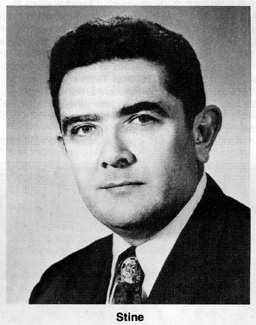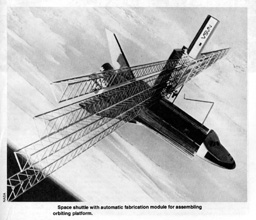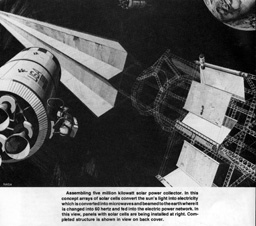 Over the centuries, the historical trend has shown that exploration is followed by utilization. This holds true whether the exploration has been geographical or the purest scientific research. Sooner or later—although decades may be required in some cases—the information garnered from the exploration of the unknown is put to use by people. If the utilization of the information from exploration produces goods or services that are of value to other people, that area of exploration suddenly finds itself the center of attention by entrepreneurs, merchants, engineers, and financiers.
Over the centuries, the historical trend has shown that exploration is followed by utilization. This holds true whether the exploration has been geographical or the purest scientific research. Sooner or later—although decades may be required in some cases—the information garnered from the exploration of the unknown is put to use by people. If the utilization of the information from exploration produces goods or services that are of value to other people, that area of exploration suddenly finds itself the center of attention by entrepreneurs, merchants, engineers, and financiers.
And financiers sign checks.
Some space scientists have loudly criticized the various space programs of the Free World for a general neglect of scientific research in favor of political goals or for the continuing development of nifty technical tricks that seemingly add nothing to the basic cupboard of knowledge. This has continued in some quarters even today on the eve of the launching of the NASA Space Shuttle—a space hardware development that can lead to the industrialization of space.
"You've had your turn with the Apollo and Skylab programs!" these scientists cry. "Now it's our turn! The NASA Space Shuttle must not be used for space industrialization at the expense of space science!"
This is a very short-sighted demand which, if acceded to, could set back space science by many decades.
Reason: American taxpayers have already given the signal that there is a limit to which they are willing to support scientists engaging in what the public perceives as the scientists' favorite hobbies. And they are signalling that the limit has been reached. Congress and the Administration are not deaf to those to whom they must look for re-election or re-appointment.
Having made this charge and given one reason for it, I will justify it as well by showing that support of space industrialization could, as a consequence, offer an incredible number of new opportunities for the conduct of space science with greater ease and at less cost than at present.
For the past decade, a number of people—NASA planners and forecasters, think-tank intellectuals, engineers, and entrepreneurs among them—have started thinking about the Solar System from a quite different point of view.
On the basis of the results of space science to date, the Solar System appears to be useful to us in addition to being a fascinating place in which to seek answers to questions. The utility falls into several areas and includes:
(a) the "high view" of Planet Earth,
(b) unique environmental characteristics such as weightlessness and hard vacuum,
(c) an abundant and renewable energy source (albeit of low energy density in comparison to what we have been used to working with), and
(d) a very large source of raw materials that can be obtained and transported with a low expenditure of energy.
In short: space industrialization.
One aspect of space industrialization alone could be cited in justification, although it doesn't offer a clear-cut case proving the contention. It does, however, have one important advantage: a track record. This portion of space industrialization is the communications/information area exemplified by comsats, earth resources satellites, and meteorological satellites. They exist. Using them we have learned a great deal about our own planet. And with them we are able to communicate directly or by linking our computers together for data processing. I could link the microcomputer on which I am writing this with the NATO computer in London via a communication satellite if I needed additional computing power or memory.
Nobody argues over comsats any longer. Not only have they proven their usefulness by handling more than half the world's communications traffic in 1979, but they have provided a very important additional incentive for more and better comsats: a return on investment.
At this moment, I'm looking at my regular quarterly dividend check from the Communications Satellite Corporation (Comsat). It isn't very much because, in 1964, I didn't have a lot of money to invest in Comsat stock. But it amounts to a total of $2.22 per share in calendar year 1979! As I look at that check, I realize that it is money that was made by using space to provide a service of value to people, including space scientists who got their data back from Pioneer, Voyager, and Viking through the deep space network utilizing comsats for orbital relay of the data because it could not have been done otherwise!
That's just one aspect of space industrialization. Let's take a look at another one that is perhaps still a decade away from realization, but which offers an even more compelling rationale for all-out support of space industrialization by space scientists with their vested interests still foremost in mind. (I have nothing against space science, by the way, having publicly stated in congressional testimony more than once that we should be doing all of it that we can possibly afford to do, plus a little bit more when it comes to unique opportunities such as a Halley's Comet fly-by or a Grand Tour.)
 On Earth, we face an impending shortage of energy derived from fossil fuels. Whether we will deplete these fossil fuel resources in decades or centuries is immaterial because we know it will happen eventually. Space industrialization offers us now a very attractive alternative energy resource: the Solar Power Satellite system first discussed in 1968 by Dr. Peter E. Glaser of A. D. Little Co. The Solar Power Satellite (SPS) system is now under intensive study in a joint NASA/Department of Energy program. At this time, there appear to be no technical, engineering, environmental, or financial barriers standing in the way of getting started on a low-cost, low-risk program using the NASA Space Shuttle to check out the critical items of the SPS system. The only barrier standing in the way of doing it is the will to do it. By 1987, we could have answers that would permit a go-no-go decision to build a pilot plant SPS with an output of 5 gigawats. If the pilot plant proves out the hardware and the economics, we could begin constructing 2 SPS units in geosynchronous orbit every year, each with a 10 gigawatt output.
On Earth, we face an impending shortage of energy derived from fossil fuels. Whether we will deplete these fossil fuel resources in decades or centuries is immaterial because we know it will happen eventually. Space industrialization offers us now a very attractive alternative energy resource: the Solar Power Satellite system first discussed in 1968 by Dr. Peter E. Glaser of A. D. Little Co. The Solar Power Satellite (SPS) system is now under intensive study in a joint NASA/Department of Energy program. At this time, there appear to be no technical, engineering, environmental, or financial barriers standing in the way of getting started on a low-cost, low-risk program using the NASA Space Shuttle to check out the critical items of the SPS system. The only barrier standing in the way of doing it is the will to do it. By 1987, we could have answers that would permit a go-no-go decision to build a pilot plant SPS with an output of 5 gigawats. If the pilot plant proves out the hardware and the economics, we could begin constructing 2 SPS units in geosynchronous orbit every year, each with a 10 gigawatt output.
 To insure that everyone is brought up to the same level here, an SPS would be a very large array of photovoltaic cells some 5 by 8 miles in extent located in geosynchronous orbit. The incident solar radiation it converts into electricity is then beamed to Earth by one of two means:
To insure that everyone is brought up to the same level here, an SPS would be a very large array of photovoltaic cells some 5 by 8 miles in extent located in geosynchronous orbit. The incident solar radiation it converts into electricity is then beamed to Earth by one of two means:
(a) a microwave beam operating at about 4 gigahertz, or
(b) a laser beam generated by direct solar pumping of several high-energy lasers in parallel.
At the moment, the laser beam seems to be the winner; last year, it was the microwave system. This is one reason that actual on-site tests need to be made in orbit. On the ground, the microwave system would utilize a "rectenna" approximately 10 x 15 miles in extent—depending upon its latitude—where the microwave beam is converted into the voltages and frequencies compatible with the local electric power grid onto which the rectenna output is switched. Laser beaming would use smaller "receivers" that would together cover about the same ground area.
Careful studies to date by several think-tanks working in co-operation with several large utility companies indicate that a 10 gigawatt SPS could be built in geosynchronous Earth orbit for approximately $2000 per kilowatt, which is what it will cost in the 1990 time period to build a coal-fired electric plant of the same capacity on Earth. Electricity provided by an SPS system built from materials hauled up out of Earth's deep gravity well has been estimated at about 27 mils per kilowatt-hour.
In 1975, the total US electric energy demand was 228 gigawatts; by the year 2000, this will grow to 940 gigawatts. So no matter what we do, we are going to have to spend $2000 per kilowatt to build power plants to supply that demand ... or the lack of energy will precipitate a gradual collapse of our social institutions, the more complex and recent ones in the international area being the first to disappear, leaving us staring at each other with our fingers on nuclear triggers. We'd better build those generating systems one way or another.
Question: Shall we build them on Earth with known technology using a fossil fuel source that pumps more radioactive carbon-14 up the stacks than ever leaked from any nuclear power reactor? Or shall we build them at the same cost per kilowatt in space utilizing a renewable energy source? Fish or cut bait; we must get the electricity somewhere.
By the year 2000, coal-fired plants may be competing for coal allocations and facing even stiffer environmental controls.
By the year 2000, we could have 26 SPS units on line carrying more than one-fourth of the US base-load.
Item: The cost of building the SPS system includes the cost of a very large and inexpensive space transportation system capable of placing payloads in low-earth orbit for less than $10 per pound. This space transportation system also makes it possible to begin utilizing extraterrestrial materials in the year 2000 and after to build additional SPS units at about one-fourth the cost of building them with earth-launched materials.
No, we do not have to continue building SPS units ad infinitum because the cheap, ubiquitous space transportation system then allows secondary industry—manufacturing—to follow the energy sources into space where the energy to operate these industries will be cheaper ... in addition to the other space environmental factors that appear to make space manufacturing so attractive. Since more than 60 percent of the US electric power output is used by industrial operations (less than 40 percent of the electricity in the US is used for domestic and civic heating and lighting), this offers the attractive consequence of actually stabilizing or lowering the electric power consumption of the US.
With an SPS system on line in geosynchronous Earth orbit in the year 2000, what are some of the consequences?
1. We can stop building coal-fired electric plants and begin to use coal and other fossil fuels in a more rational way as chemical feedstocks that may be recycled; combusted fossil fuels can't because once they're up the stack, they're gone.
2. We can shut down the nukes because our base-load is being picked up by the SPS system. This one factor alone should generate a considerable level of grass-roots support for an SPS system, judging by the growing anti-nuclear activity.
3. We will have available a big manned space transportation system and a space habitation system consisting of a wide variety of orbital and other facilities all bought and paid for that will lift space scientists and their equipment into space for one-thirtieth of the current cost ... and as often as they want to go, riding on the coat-tails of space industry ... and taking them out as far as the planetoid belt or even to the moons of Jupiter by 2010 to 2020.
Moral: If you want to do space research—lots of space research—better support a program that will produce a product or service from space that has value and that will require the establishment of a large, heavy-lift, regularly-scheduled space transportation system.
Anybody got a better idea of how to do it?
 G. Harry Stine graduated from Colorado College in Colorado Springs, Colorado (his home town) with a bachelor's degree in physics in 1952. Before embarking on a physics curriculum, he studied psychology and pre-medicine at the University of Colorado. He spent the early 1950s at White Sands missile range in New Mexico working with high altitude rocketsondes. During the 1960s he was the manager of an industrial research laboratory for a small New England company. He now consults to government and private industry on high technology marketing and future industrial activity in space, testifying several times before Congress concerning the need for future space programs.
G. Harry Stine graduated from Colorado College in Colorado Springs, Colorado (his home town) with a bachelor's degree in physics in 1952. Before embarking on a physics curriculum, he studied psychology and pre-medicine at the University of Colorado. He spent the early 1950s at White Sands missile range in New Mexico working with high altitude rocketsondes. During the 1960s he was the manager of an industrial research laboratory for a small New England company. He now consults to government and private industry on high technology marketing and future industrial activity in space, testifying several times before Congress concerning the need for future space programs.
He has written widely about the future and is the author of more than 20 books, numerous scientific and technical papers, and hundreds of magazine articles. His most recent books include "The Third Industrial Revolution" (Ace Books, 1979), "The Space Enterprise" (Ace Books, May 1980 release), and "The Hopeful Future" (Pocket Books, in press). He does all his writing on a microcomputer with a word processing program that, as a tool, he considers as far ahead of the typewriter as the typewriter was ahead of hand-written manuscripts. During the 1950s Stine founded the international hobby/sport of model rocketry. A member of many scientific and professional organizations he was awarded a silver medal by the Association of the U.S. Army for his pioneering space work. Stine is an instrument-rated pilot and owns his own airplane.
|
Intelligent Machines
The National Aeronautic and Space Administration (NASA) is currently involved in a major study of the role which machine intelligence and robot devices will play in NASA's future space operations. NASA seeks to identify opportunities for the application of machine intelligence, and to estimate the benetits of such applicatinns.
To pursue this question NASA and the American Society for Engineering Education have established a special Technology Feasibility Study for the summer of 1980. For ten weeks, between June 23 and August 29, twenty faculty members from across the United States will team up with representatives from NASA and industry to explore the evolving and potential capabilities of machine intelligence and robot devices in accelerating the pace of programs for the exploration and utilization of space.
The summer study will take place on the campus of the University of Santa Clara, near San Francisco. Arrangements are being handled by Professor Timothy J. Healy of the Department of Electrical Engineering and Computer Science at the University of Santa Clara.
|
![[NAAPO Logo]](../../Images/NAAPOsm.jpg)
![[NAAPO Logo]](../../Images/NAAPOsm.jpg)